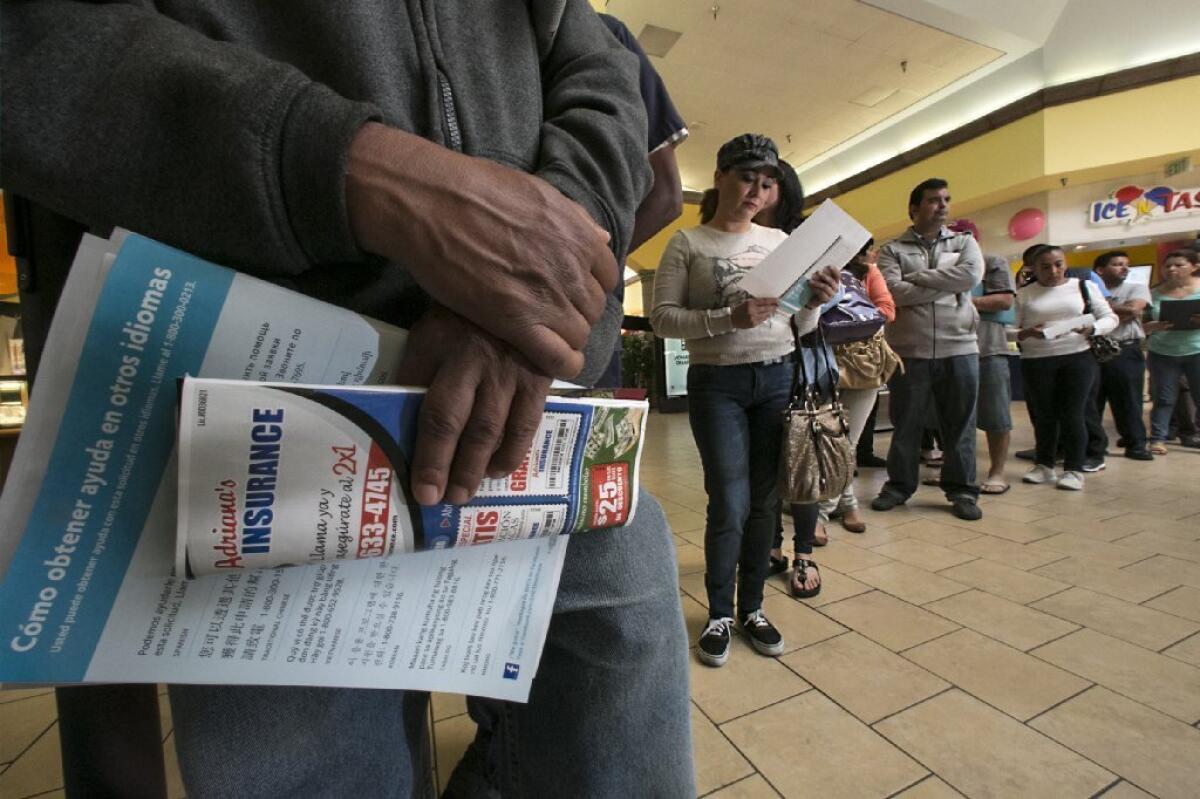Obamacare numbers coming in huge: Here’s a guide to GOP excuse-making

- Share via
Against all odds and expectations, enrollments in health plans qualified under the Affordable Care Act are surging Monday toward -- and maybe beyond -- the 7-million figure projected by the Congressional Budget Office before Oct. 1, when the open-enrollment period began. The deadline for starting enrollment applications for 2014 plans is midnight Monday.
The surge is creating a big problem for the “train wreck” narrative of Republican opponents of the ACA, who have been holding out hope for Obamacare’s utter failure. So the excuse-making has begun.
Before we examine those excuses: You will recall that the budget office reduced its projection of enrollments on individual insurance exchanges to 6 million earlier this year to account for the botched launch of healthcare.gov, the federal enrollment website. Enrollments blew past that mark days ago. If exchange enrollments meet or exceed the original projection of 7 million despite the loss of some six weeks in website functionality in October and November, that would be a testament to the public’s latent desire for effective healthcare coverage.
Photos: The battle over the Affordable Care Act
We won’t know the final March 31 tally for days, possibly weeks, but that indispensable enrollment tracker Charles Gaba is projecting 6.78 million exchange enrollments, with a chance of topping 7 million.
That figure covers enrollments in private healthcare plans via healthcare.gov and the individual websites offered by 14 states and the District of Columbia. As my colleague Noam Levey is reporting, the Rand Corp. estimates that another 4.5 million previously uninsured adults have signed up for Medicaid in states that expanded that program under the ACA. And about 3 million young adults have obtained coverage through an ACA provision allowing them to stay on their parents’ employer plans until age 26.
For Obamacare critics, consequently, the enrollment numbers demand debunking. Here’s a bestiary of their arguments for why the figures shouldn’t be believed, and explanations of why they’re off-base.
“How many have paid?” (Also known as “The statistics are full of deadbeats”): We examined this argument a few days ago. We observed that the concern is probably exaggerated and certainly premature, since many people who enrolled late in the cycle, including those in the March surge, may not have payments due for as much as six weeks after enrollment. Many haven’t even received their first monthly premium bill yet.
Figures from states that track this metric, including California and Vermont, show that 85% to 90% of enrollees have paid on time, which secures them the coverage they applied for.
“Most of them were already insured”: The argument here is that if we’ve just moved people from one insurance plan to another, we’ve just been wasting Americans’ time and subjecting them to an onerous bureaucratic procedure as well.
The claim is based primarily on a survey in January from McKinsey and Co., which concluded that only 11% of exchange enrollees had been previously uninsured. A McKinsey survey a month later raised that figure to 27% -- still low, compared to expectations.
The major problem with the McKinsey survey is that doesn’t say what its hawkers claim. The survey combines on-exchange enrollments and off-exchange enrollments; the latter are likely to heavily skew figures toward the previously insured because those are most likely people signing up again with their existing carriers. The goal of the exchange marketplaces, however, is to reach uninsured Americans. The McKinsey surveys don’t break out on-exchange signups, but it’s probably that the share of previously uninsureds in that group is higher than the combined total.
The few states that do break out their own numbers reinforce that expectation. Kentucky says that some 75% of its exchange enrollees were previously uninsured. New York says that about 60% of its exchange enrollees were previously uninsured. That number has been rising over time, raising the prospect that the March surge will include an even higher ratio of uninsured customers; Gaba, who has calculated a time series of New York enrollments based on the state’s monthly news releases, calculates that of enrollees in mid-February, at least 92% had been uninsured.
“‘Young invincibles’ aren’t signing up”: This is related to the oft-mentioned threat of a “death spiral” in the insurance market -- if the enrollees are predominantly older and sicker consumers, they’ll drive up premiums, which will discourage younger and healthier people from enrolling, which drives up premiums, which discourages, the young, etc., etc.
Federal officials have set an informal target of 40% of enrollments in the 18-34 age range. The latest figures from various states put the enrollment rate at the mid-20% level. But it was always expected that younger people would be among the last to enroll, and reports from the states suggest that’s happening.
Even if the statistics remain fixed in the mid-20s, however, the death spiral won’t be happening. The Kaiser Family Foundation estimated that even if the young enrolled at only 50% of expected levels, premiums for 2015 would have to be raised a couple of percentage points. That’s nowhere near enough to set off a death spiral.
Moreover, as we explained way back in October, the ACA has a corrective to the death spiral written in. It’s called risk adjustment, and it works by paying a subsidy to insurance companies that end up with older or sicker customer bases than they anticipated. The money comes from payments made by carriers that end up with favorable customer profiles. Republicans know this arrangement will keep Obamacare stable. How do we know? Because in a majestically cynical move spearheaded by Sen. Marco Rubio, R-Fla., they tried late last year to kill it, calling it an insurance “bailout.”
“More people got cancellations than signed up”: The numbers never supported this claim, and the latest estimates make it even more of a fantasy. It’s based on the wave of reports late last year of insurance companies canceling old policies that didn’t meet ACA standards, which led to hysterical claims that as many as 17 million Americans were being left uninsured.
Rand’s figures support earlier estimates that fewer than 1 million people who had health plans in 2013 are now uninsured because of cancellations. Insurance companies that issued the cancellation notices say they’ve retained “the vast majority” of their old customers, mostly by moving them into new, compliant, plans.
“The White House is ‘cooking the books’”: This is the last refuge of scoundrels like Sen. John Barrasso, R-Wyo., who made the claim this weekend on Fox News Sunday while the slack-jawed host, Chris Wallace, sat silently by.
What makes this claim particularly fatuous is that the most encouraging figures don’t come from the federal government at all, but from states with their own enrollment programs. The eight states with the best records of signing up their eligible citizens in exchange plans (actually seven states and D.C.), all have their own exchanges and websites. Vermont leads the parade at 83% enrolled. California, which leads all states in number of exchange enrollees at more than 1 million, ranks fourth with a 41% outreach rate.
If the feds are cooking the books, they’ve cooked them to look worse, not better -- the 36 states that dumped their enrollment responsibilities on the federal government are clustered at the bottom of the list, most of them with enrollment rates of 20% or less of eligible citizens. Many of these are states that actively discouraged or interfered with enrollments of their citizens in health insurance plans -- behavior that should be grounds for impeachment or recall of their governors and legislators.
Of course, even the enrollment of 7 million Americans in ACA exchanges doesn’t mean Obamacare is a certified success. There’s a lot of work to be done to fix the inevitable flaws in any law as far-reaching as this one. As Noam Levey reported, it amounts to the largest expansion of health coverage for Americans since the enactment of Medicare half a century ago, but many more people need to be signed up in coming years.
The apparent success of the first annual open enrollment period, however, should show Republican naysayers that this law is here to stay, with all its customer-protection provisions intact. It’s time they recognized that the rhetoric about Obamacare’s failure has gotten them nowhere. It’s gotten the country nowhere. It’s time for them to get behind the law, to help get their fellow citizens the coverage they need, and to help fix what needs to be fixed.
ALSO:
Many Americans open to narrow doctor networks in Obamacare
California says 14,500 must redo Obamacare applications after glitch
Health insurance basics stump many Obamacare shoppers, survey finds







